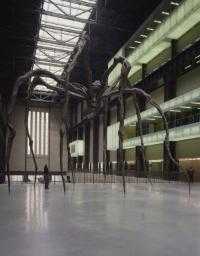For a limited time Bourgeois’s giant spider, the first work to greet visitors when Tate Modern opened in 2000, returns to the Turbine Hall after 25 years
'The spider is a repairer. If you bash into the web of a spider, she doesn’t get mad. She weaves and repairs it.' Louise Bourgeois
You can walk around and underneath this 9-metre-high steel sculpture of a female spider. Her body is suspended above the ground, supported on eight slender, knobbly legs. Underneath, she carries a mesh sac of white and grey marble eggs.
Louise Bourgeois started making sculptures of spiders in the 1990s. This version is her biggest spider. Its title, Maman, is French for mummy. The artist said spiders reminded her of her mother: ‘Like a spider, my mother was a weaver. My family was in the business of tapestry restoration, and my mother was in charge of the workshop. Like spiders, my mother was very clever … spiders are helpful and protective, just like my mother.’
Maman has a special part in Tate Modern’s history. Louise Bourgeois exhibited it as part of Tate Modern’s first Turbine Hall commission when the museum opened in 2000. It was displayed on the bridge overlooking the Turbine Hall, just as it is now. In 2007, a bronze version of the sculpture was displayed on the landscape at the front of Tate Modern.
Louise Bourgeois started out as a painter but started making sculptures when she moved to New York in the late 1940s. She wanted her art to tell stories, saying, ‘Tell your own story and you will be interesting.’
The display of Maman is supported by LVMH.

